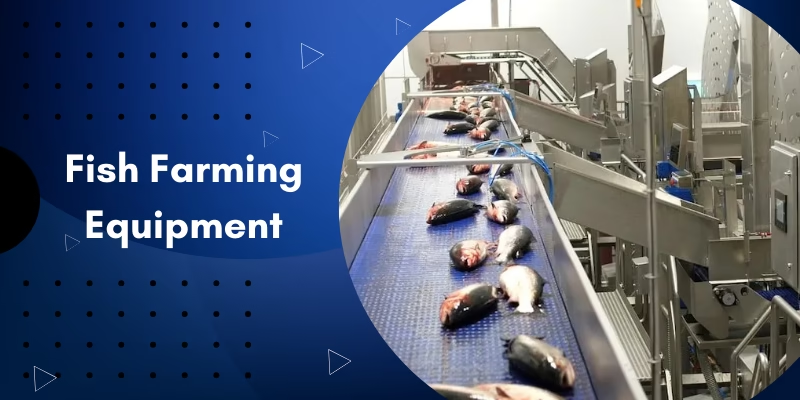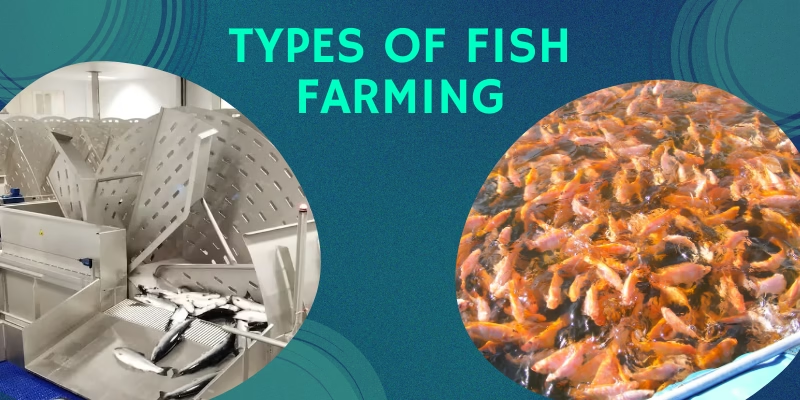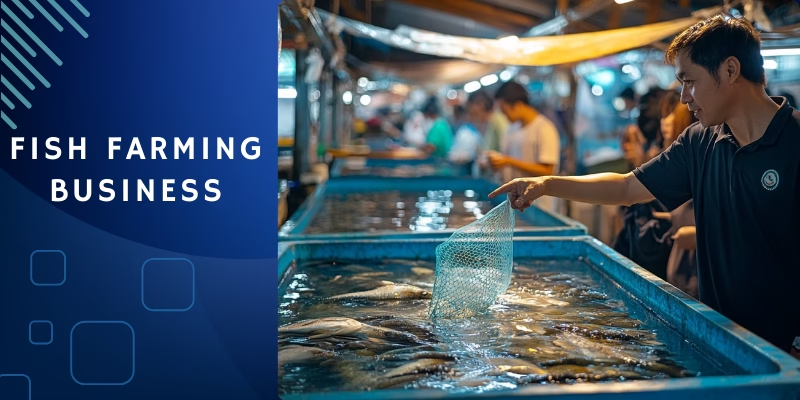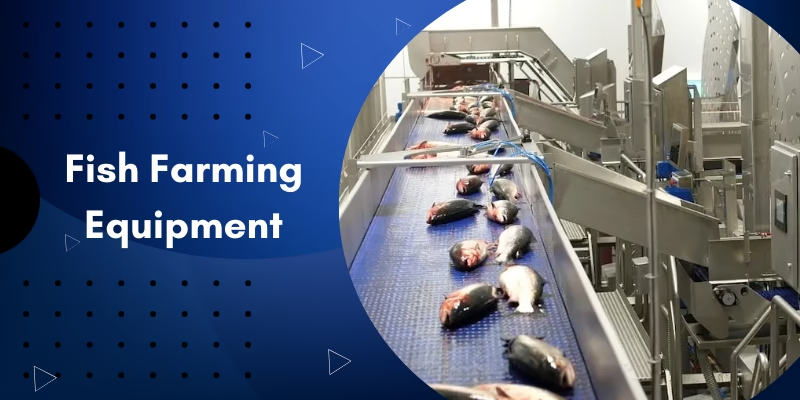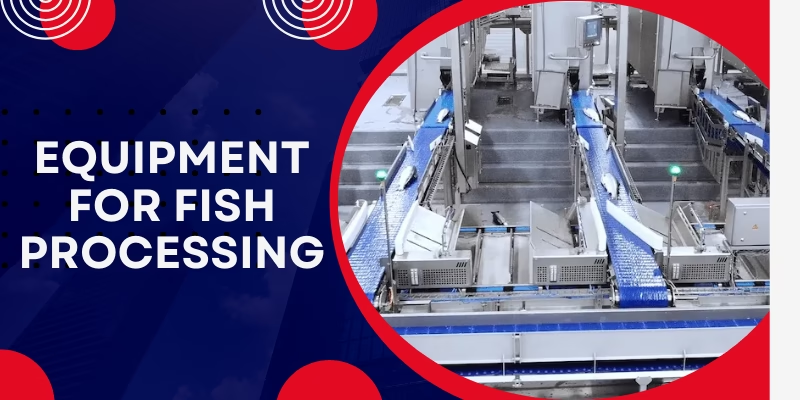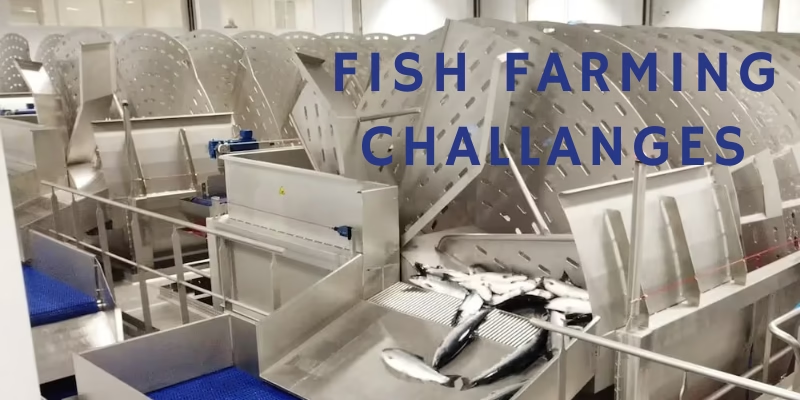Introduction
Fish farming, also called aquaculture, is the process of raising fish in controlled environments with the help of specialized fish farming equipment. This method is essential for providing food, supporting businesses, and reducing the pressure on wild fish populations. By using the right fish farming equipment, farmers can maintain water quality, feed fish efficiently, and ensure their growth and health.
In this guide, we will explore various fish farming methods, discuss how to start fish farming at home, and explain the role of sustainable practices. Proper fish farming equipment plays a key role in every step, from aerators that supply oxygen to water testing kits that monitor quality, ensuring success in this growing industry.
What is Fish Farming?
Fish farming is a way of raising fish in a controlled area like a pond, tank, or cage. This method is used to grow fish for food, business, or even fun. Unlike catching fish in rivers, lakes, or the sea, fish farming takes place in an environment where farmers can control the water, food, and care the fish receive. This helps the fish grow healthy and strong.
Why is Fish Farming Important?
Fish farming has many benefits that are helpful for people, communities, and the environment.
|
Reason |
Details |
|
Food Supply |
Fish farming produces a steady supply of fish to meet the growing demand for healthy food like fish, which is rich in protein and good for our health. |
|
Economic Growth |
It provides jobs for people who work on fish farms and supports businesses that sell fish, feed, and equipment. |
|
Sustainability |
Fish farming reduces the need to catch fish from rivers, lakes, and oceans, helping to protect wild fish populations and the environment. |
How Does Fish Farming Work?
In fish farming, the farmer selects a safe and clean area like a pond or tank. The fish are fed nutritious food and are protected from diseases. Farmers also check the water quality regularly to ensure the fish have a healthy environment to grow.By controlling these factors, fish farming ensures that the fish grow quickly and are safe for people to eat.
Types of Fish Farming
Fish farming can be done in different ways. Every approach has advantages and disadvantages of its own. Farmers choose a method based on their resources, location, and goals.
Pond Fish Farming
This is the most common way to farm fish. Farmers build ponds where they raise the fish. This method is simple and easy to set up, especially in rural areas. It is a good option for beginners because it does not require advanced tools or techniques.
Biofloc Fish Farming
Biofloc farming is a modern method. It uses tiny microorganisms to clean the water and provide extra food for the fish. This method produces more fish in a smaller space and is eco-friendly. However, it requires some experience and knowledge to manage properly.
Backyard Fish Farming
In backyard fish farming, people raise fish in small ponds or tanks at home. This method is perfect for families or small businesses. It is affordable, easy to manage, and a great way to produce fish for personal use.
Cage Fish Farming
Cage farming is the practice of putting cages in lakes or rivers that are naturally occurring.The cages protect the fish and allow water to flow freely around them. This method is cost-effective and takes advantage of natural water.
Recirculating Aquaculture Systems (RAS)
This advanced method is ideal for urban or indoor fish farming. It uses tanks with filters to clean and recycle the water. RAS saves water and gives farmers full control over the fish’s environment. While it requires a higher investment, it is very efficient and suitable for areas with limited water.
Comparison of Fish Farming Methods
|
Type |
Best For |
Advantages |
|
Pond Fish Farming |
Beginners, rural areas |
Simple and low-cost setup |
|
Biofloc Fish Farming |
Experienced farmers |
High yield and eco-friendly |
|
Backyard Fish Farming |
Small-scale users |
Affordable and easy to manage |
|
Cage Fish Farming |
Large water bodies |
Uses natural water, low cost |
|
Recirculating Systems |
Urban/Indoor farming |
Saves water, easy to control |
Sustainable Fish Farming
Sustainable fish farming means raising fish in a way that takes care of the environment while making efficient use of fish farming equipment. This approach focuses on using resources wisely to ensure that future generations can also benefit from them. By utilizing the right fish farming equipment, farmers can create a balanced system that protects nature and supports the growth of healthy fish.
Why is Sustainable Fish Farming Important?
Sustainable fish farming, supported by proper fish farming equipment, helps in the following ways:
- Save Resources: Advanced fish farming equipment like water filtration systems ensures efficient use of water and other natural resources.
- Keep Fish Healthy: Tools such as aerators and water testing kits help maintain water quality, reducing stress and diseases in fish.
- Reduce Pollution: Using efficient filtration systems and waste management tools minimizes pollution in ponds, rivers, and other water bodies.
- Protect Wild Fish Populations: Sustainable practices, combined with modern fish farming equipment, prevent over-fishing and help maintain the balance of nature.
By combining sustainable methods with innovative fish farming equipment, farmers can ensure they raise healthy fish without harming the environment. This balance is key to long-term success in aquaculture.
Tips for Sustainable Fish Farming
Farmers can follow simple steps to make their fish farming sustainable:
|
Tip |
How It Helps |
|
Use eco-friendly equipment |
Reduces harm to the environment by avoiding plastics and harmful chemicals. |
|
Avoid overcrowding |
Gives fish enough space to grow, reducing stress and the chances of getting sick. |
|
Manage water quality |
Keeps the water clean and prevents pollution, which is good for fish health. |
|
Rotate fish species |
Helps maintain balance in the ecosystem by giving the pond or tank time to recover. |
How to Start Sustainable Fish Farming
- Use natural or recycled materials for building ponds and tanks.
- Feed fish with natural or organic food when possible.
- Regularly check water for cleanliness and good oxygen levels.
- Learn about local fish species that are easier to grow and better for the environment.
Fish Farming at Home
Fish farming at home is an enjoyable hobby that becomes even more effective with the right fish farming equipment. Whether you’re raising fish in a small tank or a backyard pond, having the right tools ensures the fish grow healthy and strong. This activity not only provides food but can also be a source of extra income for families.
Why Start Fish Farming at Home with Fish Farming Equipment?
- Fun Hobby: Using fish farming equipment, such as nets and aerators, makes it easier and more enjoyable to learn about animals and water systems while caring for your fish.
- Food Supply: With proper fish farming equipment, you can raise your own fish to eat, ensuring fresh and healthy food for your family.
- Extra Income: Investing in quality fish farming equipment can help you raise fish efficiently, allowing you to sell them and earn additional income.
By incorporating essential fish farming equipment, you can turn your home fish farming project into a rewarding and productive experience.
Steps to Start Fish Farming at Home
Here are the steps to get started with fish farming in your backyard or home:
|
Step |
Details |
|
1. Choose Fish Species |
Start with fish that are easy to raise. Good options include Tilapia, catfish, and goldfish. |
|
2. Set Up a Tank or Pond |
Use clean water for your fish. Make sure the tank or pond is big enough for the fish to swim and grow. |
|
3. Feed Your Fish |
Feed the fish healthy food like fish pellets. Make sure to feed them enough, but don’t overfeed them. |
|
4. Monitor Water Quality |
Check the temperature, oxygen levels, and cleanliness of the water. Healthy water helps fish grow. |
|
5. Harvest Your Fish |
Once the fish have grown, you can catch and eat them, or sell them to others. |
Additional Tips for Successful Home Fish Farming
Using the right fish farming equipment can make a big difference in the success of your home fish farming. Here are some tips to help you:
- Choose the Right Location: Place your tank or pond in a safe spot that gets enough sunlight. With the help of fish farming equipment, such as temperature monitors, you can ensure the environment is perfect for your fish.
- Keep the Water Clean: Use water filtration systems, an essential piece of fish farming equipment, to keep the water fresh and safe for the fish. Regular water changes, along with testing kits, will also help maintain cleanliness.
- Observe Your Fish: Tools like aerators, part of standard fish farming equipment, ensure your fish stay healthy by keeping oxygen levels high. Watching for signs of illness or stress in your fish allows you to take quick action with the proper fish farming equipment.
Incorporating fish farming equipment into your home setup not only simplifies tasks but also ensures a thriving environment for your fish.
Starting a Fish Farming Business
Although it takes careful planning, starting a fish farming business can be a terrific way to make money. It can be quite profitable if done correctly. Here are the steps to help you begin your fish farming business.
Steps to Start a Fish Farming Business
Follow these simple steps to get your fish farming business off the ground:
|
Step |
Details |
|
1. Research the Market |
Find out which types of fish are in demand in your area. Look for fish that people want to buy. |
|
2. Create a Business Plan |
Write a plan that includes how much money you will spend, how much you expect to earn, and how to market your fish. |
|
3. Choose a Location |
Pick a place that has access to clean water and enough space for your fish farm. Make sure it is safe for fish. |
|
4. Buy Healthy Fingerlings |
Buy young fish (called fingerlings) from trusted suppliers to ensure they are healthy and grow well. |
|
5. Invest in Equipment |
You will need tools like aerators to supply oxygen to the water, water testing kits, and feeders to feed your fish. |
Example Cost Estimate for Fish Farming
Starting a fish farm requires money for different things. Here’s an illustration of what you could spend:
|
Item |
Cost (USD) |
|
Pond Construction |
1,000 – 5,000 |
|
Fish Seed (per 1,000) |
50 – 200 |
|
Feed (monthly) |
100 – 500 |
|
Equipment |
500 – 2,000 |
|
Miscellaneous Expenses |
200 – 1,000 |
Important Tips
- Start small: Begin with a small fish farm until you understand how it works.
- Keep learning: Stay updated on the best fish farming practices to improve your farm.
- Manage your farm well: Make sure to care for your fish, monitor water quality, and keep track of costs.
Fish Farming Equipment
Proper fish farming equipment is essential for making fish farming efficient and productive. The right tools not only help maintain a healthy environment for the fish but also ensure good growth and profitability. Below are some of the essential fish farming equipment needed for successful fish farming.
Aerators
Aerators are a crucial part of fish farming equipment as they add oxygen to the water, which is vital for fish survival. Fish need oxygen to breathe, just like humans, and insufficient oxygen levels can lead to fish becoming sick or even dying.
- How They Work: Aerators push air into the water, creating bubbles that mix with the water and increase oxygen levels.
- Types: There are pond aerators that float on the water surface and diffused aerators that release oxygen from the bottom of the water.
Water Testing Kits
Water testing kits are another key component of fish farming equipment. They help monitor water quality by checking important factors like pH levels, temperature, and oxygen content. Good water quality is essential for fish health and growth.
- Why They’re Important: Poor water quality can harm the fish, hinder their growth, or make them sick.
- Types of Tests: pH test kits, oxygen level meters, and temperature thermometers are commonly used.
Fish Feeders
Fish feeders are indispensable in any set of fish farming equipment. They ensure that fish are fed evenly, preventing underfeeding or overfeeding. Feeding fish manually can be time-consuming, so feeders make the process more efficient.
- How They Work: Automatic feeders release food at set times, while demand feeders release food when triggered by fish.
- Types: Automatic feeders and demand feeders are the most popular options.
Nets
Nets are versatile fish farming equipment used for handling and harvesting fish safely. They allow farmers to catch and sort fish without causing harm.
- How They Work: Nets are used to catch fish from ponds or tanks and to sort them by size or species.
- Types: Large seine nets are used for large-scale harvesting, while small dip nets are perfect for handling individual fish.
Filtration Systems
Filtration systems are vital pieces of fish farming equipment that keep the water clean and safe. They remove waste, dirt, and harmful substances, ensuring a healthy environment for fish to grow.
- How They Work: Mechanical filters remove solid debris, while biological filters break down toxins from fish waste.
- Types: Mechanical filters for debris removal and biological filters for chemical breakdown are commonly used.
Having the right fish farming equipment is the foundation of a successful fish farm. Aerators ensure adequate oxygen levels, water testing kits maintain optimal water quality, fish feeders make feeding efficient, nets allow for safe fish handling, and filtration systems keep the water clean. By investing in the proper fish farming equipment, you can create a thriving environment for your fish and achieve better results.
Fish Hatchery Tools and Equipment
Fish hatchery tools and equipment are essential for breeding and hatching fish successfully. These tools help create the right environment for fish spawning and ensure the healthy growth of fry and fingerlings. Proper maintenance and disinfection of this equipment are crucial to prevent issues like fungal infections, which can harm the young fish.
High-quality equipment plays a significant role in the growth and survival of fish. Below are some commonly used tools and equipment in fish hatcheries, along with their uses, availability, prices, and recommended brands:
Fish Hatchery Tools and Equipment
|
Equipment |
Uses |
Availability (USA) |
Price Range (USD) |
Best Brands |
|
Bed hatchery trout |
A pond for growing and raising fingerlings right after spawning. |
Aquaculture stores, online shops |
$500 – $2,000 |
Pentair, Aquatic Eco-Systems |
|
Recirculating drum |
Advanced pond for fingerling growth post-spawning. |
Specialty aquaculture suppliers |
$1,000 – $5,000 |
RAE Systems, OxyGuard |
|
Wide bow |
Temporary housing for broodstock and transporting fry or fingerlings. |
Farm supply stores, online shops |
$50 – $200 |
Ketchum, Frabill |
|
Egg hatching jar |
Temporary housing for broodstock, hatching eggs, and transporting fry. |
Aquaculture equipment suppliers |
$30 – $150 |
Pentair, Aquaneering |
|
Kakaban (spongy nets) |
Collects fertilized eggs, prevents them from sinking, and aids hatching. |
Local fish farming suppliers |
$20 – $100 |
Custom-made, Pentair |
|
Razor blade/surgical knife |
Used to extract fertilized eggs from the broodstock. |
Pharmacy, online marketplaces |
$5 – $20 |
Feather, Stanley |
|
Hypodermic syringe |
Injects pituitary gland extract into broodstock for hatching. |
Pharmacy, vet supply stores |
$10 – $50 |
BD, Terumo |
|
Clean rag/cloth |
Holds fish eggs during injection procedures. |
Grocery stores, online shops |
$5 – $15 |
Any high-quality cotton brand |
|
Hand gloves |
Protects hands when handling broodstock and eggs. |
Pharmacy, online stores |
$10 – $30 |
Ansell, Microflex |
|
Ovaprim/pituitary hormone |
Synthetic hormone used to induce spawning in broodstock. |
Aquaculture supply stores |
$50 – $200 |
Syndel, Ovaprim |
Water Screening, Monitoring, and Control Equipment
Maintaining good water quality is vital for fish health. Factors like pH levels, salinity, and water turbidity affect fish survival and growth. Below are some tools used for monitoring and controlling water quality in ponds:
|
Equipment |
Uses |
Availability (USA) |
Price Range (USD) |
Best Brands |
|
pH scale/indicator |
Measures the acidity or alkalinity of pond water. |
Online retailers, lab supply stores |
$20 – $150 |
Hanna Instruments, LaMotte |
|
Thermometer |
Checks the temperature of the pond water. |
Local hardware stores, online |
$10 – $50 |
ThermoPro, Vee Gee |
|
Secchi disc |
Measures water turbidity (clarity). |
Specialty aquaculture suppliers |
$50 – $200 |
Pentair, Wildco |
|
Refractometer |
Determines the water’s salinity and composition. |
Scientific equipment retailers |
$30 – $200 |
Milwaukee, Atago |
|
Hydrometer |
Assesses the density or specific gravity of the water. |
Online retailers, lab stores |
$20 – $100 |
Eisco, API |
|
Pumping machine |
Pumps water into ponds or tanks. |
Farm equipment stores, online |
$200 – $1,500 |
Honda, Tsurumi |
|
Oxygen aerator |
Supplies oxygen to the pond water. |
Aquaculture equipment suppliers |
$300 – $3,000 |
Kasco Marine, AquaMaster |
Fish Harvesting Equipment
Harvesting fish is a crucial and enjoyable part of fish farming. Various tools are used to catch fish, either in ponds or in the wild. Here is a list of some common fish harvesting equipment:
|
Equipment |
Uses |
Availability (USA) |
Price Range (USD) |
Best Brands |
|
Boats |
Used to transport harvested fish from ponds or the wild. |
Marine supply stores, online |
$500 – $5,000 |
Yamaha, Pelican |
|
Gill nets |
Nylon nets of various sizes for catching fish in the wild. |
Fishing supply stores, online |
$50 – $300 |
Promar, Frabill |
|
Traps |
Made of wood or nylon, used to catch fish in ponds. |
Local hardware stores, online |
$20 – $150 |
Custom-made, Promar |
|
Hook and line |
Nylon lines with hooks for catching fish in ponds. |
Fishing gear shops, online |
$10 – $50 |
Mustad, Gamakatsu |
|
Hooks |
Metal rods for catching fish in ponds. |
Fishing supply stores |
$5 – $20 |
Eagle Claw, VMC |
|
Fishing rods |
Slim rods for fishing in ponds or the wild. |
Sporting goods stores, online |
$20 – $200 |
Ugly Stik, Shimano |
|
Fishing reels |
Used to cast and mend fishing nets. |
Sporting goods stores, online |
$30 – $150 |
Penn, Abu Garcia |
|
Fishing bait |
Added to hooks to attract fish. |
Fishing supply stores, online |
$5 – $30 |
Berkley, Rapala |
|
Spears |
Sharp rods for catching fish by piercing. |
Hunting gear stores, online |
$30 – $100 |
Custom-made, Cressi |
|
Seine nets |
Long, bag-like nets used on boats to catch fish. |
Marine supply stores, online |
$200 – $2,000 |
Frabill, Promar |
|
Baskets |
Used to scoop fish from ponds. |
Local markets, online |
$10 – $50 |
Custom-made |
|
Cutlass |
Cuts fish or helps mend nets. |
Hardware stores, online |
$10 – $30 |
Stanley, Fiskars |
Fish Preservation and Storage Equipment
To prevent spoilage and microbial attacks, fish need proper preservation after harvesting. Various tools and machines are available to store fish safely and keep them fresh:
|
Equipment |
Uses |
Availability (USA) |
Price Range (USD) |
Best Brands |
|
Fish container |
Transports chilled fish and other aquatic products. |
Aquaculture suppliers, online |
$50 – $300 |
Igloo, Pelican |
|
Fish holds |
Stores fish on a large scale during transportation. |
Marine supply stores |
$500 – $3,000 |
Custom-made, Pentair |
|
Fish boxes |
Supplies and transports fish in smaller quantities. |
Fish supply stores, online |
$30 – $200 |
Cambro, Igloo |
|
Skinning machines |
Removes the skin from fish. |
Processing equipment suppliers |
$1,000 – $10,000 |
Baader, Nikko |
|
Scaling machines |
Skins and descales fish. |
Processing equipment suppliers |
$1,000 – $8,000 |
Baader, Trio |
|
Heat-treating machine |
Heats, dries, smokes, or cooks fish. |
Specialty equipment stores |
$500 – $5,000 |
Talsa, Henkelman |
|
Defrosting machine |
Defrosts frozen fish. |
Processing equipment suppliers |
$500 – $2,000 |
Custom-made, Nikko |
|
Cutting machine |
Cuts frozen fish and aquatic animals. |
Food processing suppliers |
$1,000 – $5,000 |
Baader, Marel |
|
Knives |
Used for cutting, skinning, and descaling fish. |
Grocery stores, online shops |
$10 – $50 |
Wüsthof, Victorinox |
|
Smoking kiln |
Dries fish through smoking. |
Fish processing suppliers |
$500 – $3,000 |
Custom-made, Weston |
|
Canning machine |
Packs fish into cans for storage. |
Processing equipment suppliers |
$5,000 – $20,000 |
All-Fill, Angelus |
|
Freezing machine |
Keeps fish frozen for long-term storage. |
Appliance stores, online |
$500 – $10,000 |
Frigidaire, Haier |
With proper tools and equipment, fish farming can be a highly productive and rewarding activity.
Summary of Equipment
|
Equipment |
Purpose |
|
Aerators |
Add oxygen to the water to keep fish healthy. |
|
Water Testing Kits |
Monitor water quality (pH, temperature, oxygen). |
|
Fish Feeders |
Distribute food evenly to all fish. |
|
Nets |
Handle and harvest fish safely. |
|
Filtration Systems |
Keep water clean and safe for fish. |
These essential pieces of fish farming equipment will help you run a successful fish farm. Keeping the water clean, feeding the fish properly, and making sure they get enough oxygen are all important for their health and growth.
| Company Name | Location | Products | Specifications | Price |
| Consolidated Cordage Corporation | Stuart, FL | Fish farm netting | Custom and standard netting solutions for aquaculture applications. | Contact for pricing. |
| Spectrapure | Tempe, AZ | Water filtration and purification systems | Reverse osmosis, deionization, RO/DI, carbon, and sediment filtration systems for aquaculture. | Contact for pricing. |
| Westmoor Ltd., Industrial Div. | Sherrill, NY | Aerator kits | Kits including compressor units, air hoses, and diffuser units. | Contact for pricing. |
| Golden Harvest, Inc. | Burlington, WA | Gates for fish farms | Various types of gates: sluice, stop, roller, tide, slide, weir, radial, flap, shear, and diversion. | Contact for pricing. |
| Cablevey Conveyors | Oskaloosa, IA | Wire mesh | Steel wire mesh in square, rectangular, and hexagonal patterns. | Contact for pricing. |
| Nelson and Pade | Montello, WI | Aquaponic systems | Patented Clear Flow Aquaponic Systems with ZDEP, available as kits, modules, or system packages. | Contact for pricing. |
| Netech | Guangzhou, Guangdong, China | Ozone generators | Large ozone generators for odor removal and water quality improvement in fish farming. | Contact for pricing. |
| Saibainuo | Jinan, Shandong, China | Floating feed machines | Automatic machines with capacities from 1,000 to 3,000 kg/h. | Contact for pricing. |
| GESIKAT | Not specified | Plastic floating fish cages | HDPE floating cages designed for durability and flexibility in aquaculture applications. | Contact for pricing. |
| Toford Aquaculture | Not specified | HDPE round floating fish cages | HDPE cages suitable for various aquaculture applications. | Contact for pricing. |
| Aqualine | Not specified | FrøyaRing® cages | Floating cages designed for durability and flexibility in aquaculture. | Contact for pricing. |
| Asakua | Not specified | Plastic submersible fish cages | Submersible HDPE cages designed for aquaculture applications. | Contact for pricing. |
| Centraltubi Spa | Not specified | HDPE pipes for aquaculture | High-density polyethylene (HDPE) pipes for aquaculture applications. | Contact for pricing. |
| Towing Cages | Not specified | Towing cages for fish farming | Cages designed for safe transfer of fish from fishing areas to storage. | Contact for pricing. |
Biofloc Fish Farming
Biofloc fish farming is a modern method of fish farming that uses microorganisms to help break down fish waste and convert it into food. The system creates a natural ecosystem where fish can thrive without needing large amounts of feed. It also helps in maintaining water quality.
How Biofloc Fish Farming Works
In a biofloc system, the water in the fish tank is treated with microorganisms such as bacteria and algae. These microorganisms feed on the waste produced by the fish. As they grow, they form clusters or “flocs” that fish can consume as food. This way, waste is not just removed from the water, but it becomes part of the fish’s diet.
Benefits of Biofloc Fish Farming
|
Benefit |
Description |
|
Reduces Feed Costs |
The fish can eat the microorganisms in the water, reducing the need for extra feed. |
|
Improves Water Quality Naturally |
Microorganisms help break down waste, keeping the water clean and healthy for the fish. |
|
Allows High-Density Fish Farming |
The system can support a large number of fish in a smaller space because it maintains good water quality. |
Why Choose Biofloc Fish Farming?
Using fish farming equipment in biofloc fish farming makes this innovative method even more efficient and beneficial.
- Low Feed Costs: Biofloc farming reduces the need for commercial fish feed by converting waste into food, and with the right fish farming equipment like aerators and biofloc systems, costs can be minimized further.
- Healthy Water: Specialized fish farming equipment, such as water testing kits and filtration systems, ensures the water is cleaned naturally and remains safe for the fish.
- Efficient Farming: With advanced fish farming equipment, farmers can raise more fish in less space, making biofloc farming ideal for smaller farms or urban setups.
This eco-friendly method, when combined with the proper use of fish farming equipment, helps create a sustainable environment for raising fish. It’s an excellent choice for farmers seeking cost-effective, productive, and environmentally responsible ways to engage in fish farming.
Challenges in Fish Farming
Fish farming is a great way to produce fish for food, but it also comes with certain challenges. Proper use of fish farming equipment can help manage these challenges and ensure the farm is both successful and sustainable.
Diseases
Fish are prone to diseases, especially when water quality is poor or there are too many fish in one area. Without the right fish farming equipment, diseases can spread quickly, harming or even killing the fish.
- Cause: Poor water quality or overcrowding.
- Solution: Using fish farming equipment like water testing kits to monitor quality and aerators to maintain oxygen levels can prevent disease. Ensuring enough space for each fish is also crucial.
High Feed Costs
Feeding the fish is one of the largest expenses in fish farming. Quality feed is necessary to keep the fish healthy and growing well, but it can be expensive, especially for large-scale operations.
- Cause: The need for high-quality feed to maintain fish health.
- Solution: Utilizing automated feeders, a type of fish farming equipment, can minimize waste and distribute feed efficiently. Additionally, systems like biofloc farming or growing your own feed can help lower costs.
Environmental Risks
Fish farming can negatively impact the environment if not managed carefully. Waste produced by fish can pollute the water, harming nearby ecosystems and wildlife.
- Cause: Poor waste management and water pollution.
- Solution: Proper filtration systems, an essential component of fish farming equipment, can remove waste and improve water quality. Implementing sustainable practices with modern equipment can also minimize environmental risks.
By addressing these challenges with the right fish farming equipment, farmers can create a healthier environment for their fish and reduce costs while protecting the surrounding ecosystem.
Summary of Challenges
|
Challenge |
Cause |
Solution |
|
Diseases |
Poor water quality and overcrowding |
Regular water testing and proper spacing |
|
High Feed Costs |
Expensive quality feed |
Use biofloc farming or grow your own feed |
|
Environmental Risks |
Waste and water pollution |
Proper filtration and waste management practices |
While challenges in fish farming may seem difficult, proper management and the use of advanced fish farming equipment can make it a profitable and sustainable business.
Fish farming is a valuable method for producing food and supporting livelihoods. Whether you are interested in backyard fish farming, biofloc technology, or starting a large-scale fish farming business, the right fish farming equipment, such as LED grow lights, can play a key role in your success like in Smart Farming. Tools like aerators, filtration systems, LED grow lights, and automated feeders help ensure the fish grow in a healthy and controlled environment.
By adopting sustainable practices and investing in high-quality fish farming equipment, including LED grow lights, fish farming can become a rewarding and environmentally friendly activity. No matter the scale of your operation, proper equipment and methods adopted in Smart Agricultural Farming and Fish Farming make it easier to achieve both profitability and sustainability..
Frequently Asked Questions
What is fish farming?
Fish farming is the practice of growing fish in controlled environments for food, business, or recreation.
Where does fish farming take place?
It happens in ponds, tanks, or other enclosures.
What are the benefits of fish farming?
It provides a steady food supply, creates jobs, and helps reduce over-fishing.
What is biofloc fish farming?
Biofloc fish farming uses microorganisms to convert fish waste into food, improving water quality and reducing feed costs.
How does fish farming help the environment?
It reduces over-fishing in oceans and freshwater bodies and can be more sustainable with proper management.
What fish are best for farming?
Tilapia, catfish, and trout are popular choices for fish farming.
Can fish farming be done at home?
Yes, fish farming can be done at home in small tanks or ponds for personal use or small businesses.
What equipment is needed for fish farming?
Aerators, water testing kits, fish feeders, nets, and filtration systems are essential for fish farming.
How much water do fish farms need?
Fish farms need a reliable source of clean water, with proper oxygen levels and temperature control.
Is fish farming expensive to start?
The cost varies depending on the scale, but it requires investment in equipment, fish, and water management systems.
What are the challenges in fish farming?
Challenges include diseases, high feed costs, and environmental risks like waste pollution.
How can fish diseases be prevented?
Regular water testing, proper spacing, and keeping fish in healthy environments can help prevent diseases.
What is the role of aerators in fish farming?
Aerators add oxygen to the water, which is necessary for fish to breathe and stay healthy.
How do fish farmers feed their fish?
Fish are typically fed commercial fish feed, but biofloc systems allow fish to eat microorganisms in the water.
What is the best way to manage water quality in fish farms?
Regular testing and the use of filtration systems help maintain clean and healthy water.
How do fish farms prevent pollution?
Proper waste management, filtration systems, and rotating fish species help prevent pollution.
Can fish farming be done in urban areas?
Yes, systems like Recirculating Aquaculture Systems (RAS) allow for fish farming in urban and indoor environments.
What are the advantages of biofloc fish farming?
It reduces feed costs, improves water quality naturally, and supports high-density fish farming.
What are common fish farming methods?
Pond fish farming, cage fish farming, and biofloc fish farming are popular methods.
How long does it take to grow fish for harvest?
The growth time varies by species, but most fish take several months to a year to reach market size.

